6 min read 🤓
public places, hidden islands
[ Rue Cassette | À Beethoven ]
february 17, 2010.
If I were a wealthy man, I probably would spend most of my time like an Aléatorix, like a leaf on a stream, drifting along the streets of our world's metropolises. I find little more rewarding than such urban explorations, whose goals remain hidden, until - every now and then, always when you least expect them to - these suddenly reveal themselves, when, without a shadow of a doubt, you know that this and here was what you had been looking for.
i.
Thus it happened one sunny day last summer (it was on a wednesday, the first of july) that, somewhere in the sixth arrondissement of the fine city of Paris, I suddenly found myself in the rue Cassette.
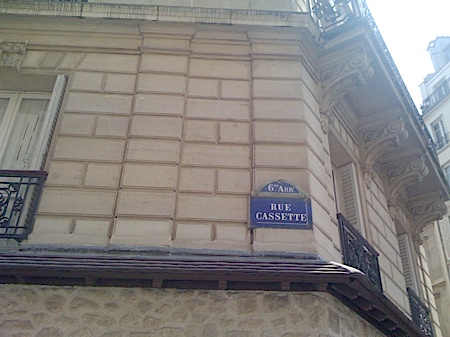
The rue Cassette is about 300 meters long, and connects the rue de Vaugirard with the rue de Rennes. Walking from the one to the other, one crosses the rue Honoré Chevalier, the rue de Mézières and the rue Marie Pape-Carpentier. At the beginning, one passes along a long stretch of blind wall, with which one can imagine doing all sorts of things. It is a narrow one-way street, where the pavement stretches out before you: indeed, as if it were a stretch of tape.
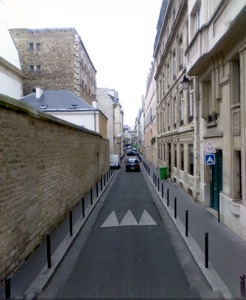 |
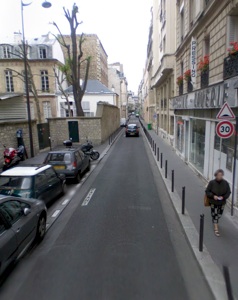 |
This is, clearly, the reason why the street is called rue Cassette. ( * )
On the corner with the rue Mézières there's a Maison Cassette, selling wooden furniture. And at the very end, on the corner with the rue de Rennes, much like the pot of gold at the end of the rainbow, there even is a Café Cassette...
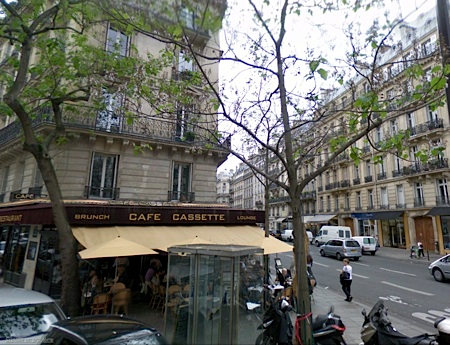
Now, of course something is meant and due to happen on this little island, both hidden and outstanding in the vast Parisian sea. And something surely will. Just you wait and see.
ii.
The next one's even better.
...
Over the past ten days or so, I went through another moderate case of Beethoven-itis.
Nothing serious, I assure you. It just happens, every once in a while, that
I have this irrational urge to hear Beethoven
symphonies all day long, urge that I can control only with the greatest possible effort
of will. (Why? With my analyst we have been going through this
ad nauseam. She thinks I keep the reason
stowed away on a little ile, that I've been hiding ever since my early youth. Bref. I guess she's right.
To not interrupt the flow of the story too much, let me refrain from going into that,
at least for now...)
Anyway.
As there were no compelling reasons not to, I gave in to the urge.
And to complement my pile of Beethoven CDs, I spent an evening of downloading
massively, looking specifically for the earliest recordings that I could
find. (The internet-archive had a couple of interesting ones: from the 1930s,
with Arturo
Toscanini conducting; and a Berlin Philharmoniker's Eroica
from 1929, with self-acclaimed anti-modernist Hans
Pfitzner handling the baton.) The next morning I dumped the
near to 22 hours of recordings of Beethoven symphonies that I had collected
onto my iPhone and popped in the earplugs, in order not to drive my family
nuts.
I then cranked up the volume, and went about my usual business.
Yesterday was a wonderful day. It was rather cold, but the sun was shining brightly and looking out from my window, over the houses on the other side of the street a deep blue sky was drawn. There was not the slightest whiff of cloud in sight.
I decided to take my bicycle out for a long random drive through the Bois de Vincennes. Meanwhile my iPhone continued to belch recordings of Beethoven symphonies, in all sorts of moods, tempi and sizes. It was thus listening to a recording of the seventh - which, again this time, came out as my favorite - that on the Fontenay side of the Bois, in a part of the park that I had never been to before, I noticed the contours of what looked like an enormous lump of old stone, standing somewhat lost between the trees where once there had been a royal park, now the middle of a nowhere. It seemed to be there for no particular reason and with no particular sign. A guy stood jumping up and down on top of it, teasing a couple of barking dogs that were circling the big brick. They tried in vain to jump or climb onto it and join the jumping boy. A couple of minutes passed. Then the guy got fed up with the game. He climbed off the stone and led the dogs on, further down into the park.
I steered my orange Peugeot bike to the right and struggled along a strip of mud that ran across the lawn, towards the group of trees in the midst of which there was that gigantic piece of stone.
This is what I saw:
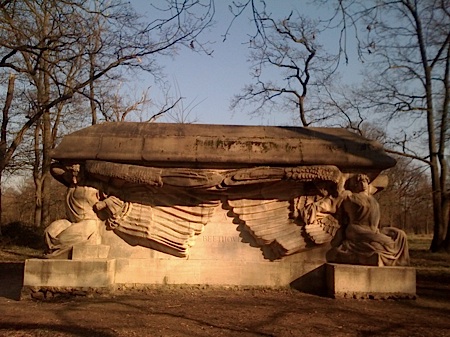
The thing measures approximately 6 meters by 4 meters, and is about 3 meters high. It looks like a tomb, with a different winged sculpture guarding each of its four corners. Only when I came closer I managed to read the inscription between the two wings.
I almost fell off the bike.
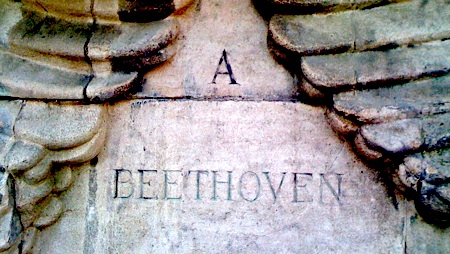
...
This is the story ( ** ):
Early 20th century a group of French Beethoven admirers came together in a Comité du Monument Beethoven (Beethoven Monument Committee), which strived for the making of a French monument in honor of the composer, which was to be placed somewhere in the French capital. The sculptor José de Charmoy was charged with its creation. But José, like so many other young frenchmen, was sent to war in 1914. Now, some web sources say he then died at war, already in 1914. Others say that he died later, shortly after the war, in 1919. Still others mention both. Fact is though that José never got the time to finish his Beethoven statue. He did finish the base, though, which is the thing that I bumped into yesterday, while biking in the Bois de Vincennes.
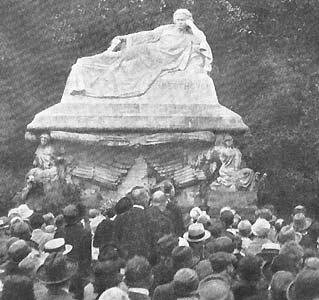 The
Beethoven that was to be up there lying naked breasted and thinking, in the
best of the idea of a suffering romantic creative's tradition, was only
ever realized in plaster. This plaster model was put on top of the base
in 1927, as you can see in the picture to the left. It however rapidly degraded,
and eventually sort of ... fell apart. Leaving but the enormous stone base
and its four winged génies, standing pretty much forgotten on that
lawn on the Fontenay side of the Bois de Vincennes. Promises to raise the
money necessary to have another sculptor make a stone version of de
Charmoy's model, or even come up with a totally different top, never
led to anything. Nothing will ever be, but the base.
The
Beethoven that was to be up there lying naked breasted and thinking, in the
best of the idea of a suffering romantic creative's tradition, was only
ever realized in plaster. This plaster model was put on top of the base
in 1927, as you can see in the picture to the left. It however rapidly degraded,
and eventually sort of ... fell apart. Leaving but the enormous stone base
and its four winged génies, standing pretty much forgotten on that
lawn on the Fontenay side of the Bois de Vincennes. Promises to raise the
money necessary to have another sculptor make a stone version of de
Charmoy's model, or even come up with a totally different top, never
led to anything. Nothing will ever be, but the base.
And of course all your base are belong to us: this public place, little hidden island, will make a perfect scene for an open air Diktat.
We'll be doing A Beethoven.
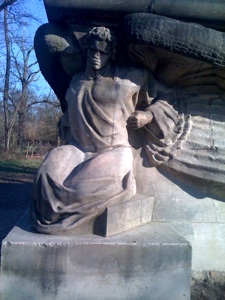 |
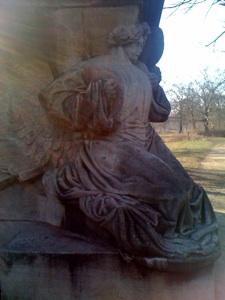 |
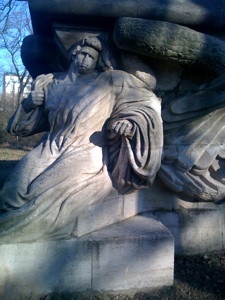 |
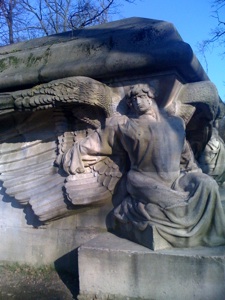 |
notes __ ::
(*) Some
say that the street's name became thus by corruption from an earlier one, rue
de Cassel... but that's humbug! [
^ ]
(**) I found the information on
the www.lvbeethoven.com web site. [
^ ]
tags: Beethoven, cassette, dérive, Paris, Vincennes
# .350.
smub.it | del.icio.us | Digg it! | reddit | StumbleUpon
comments for public places, hidden islands ::
|
Comments are disabled |